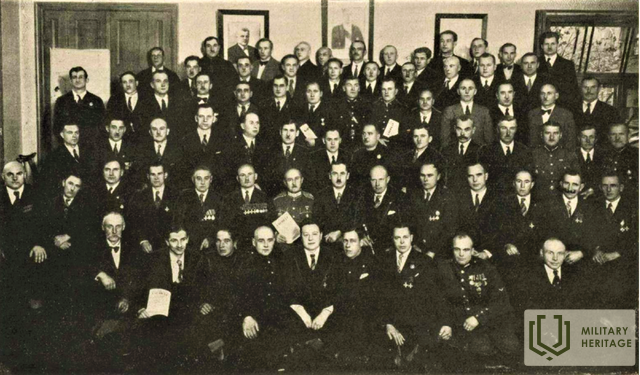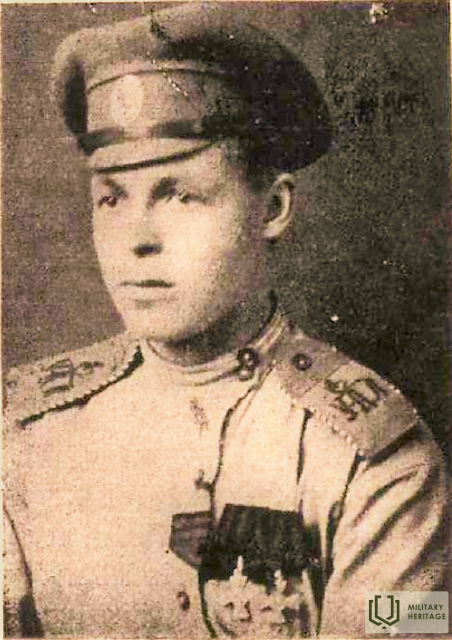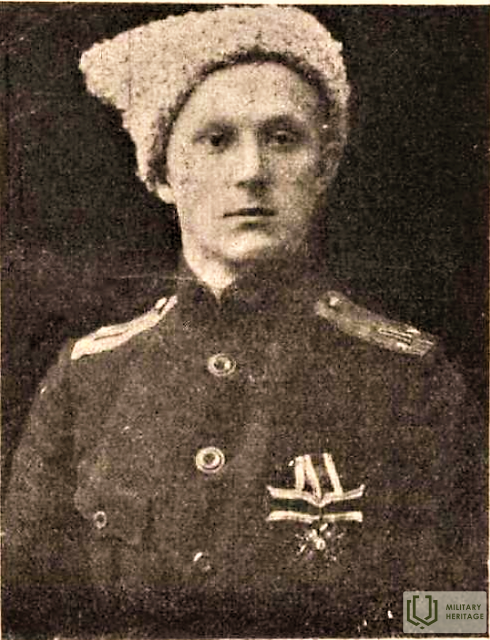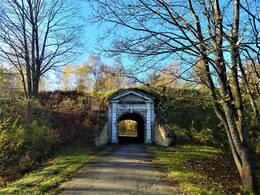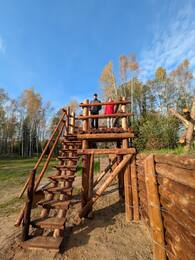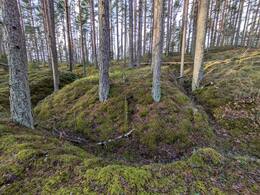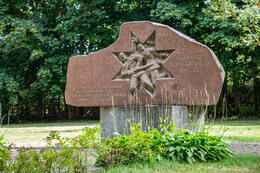1-asis Daugavgrivos latvių šaulių pulkas I WW1
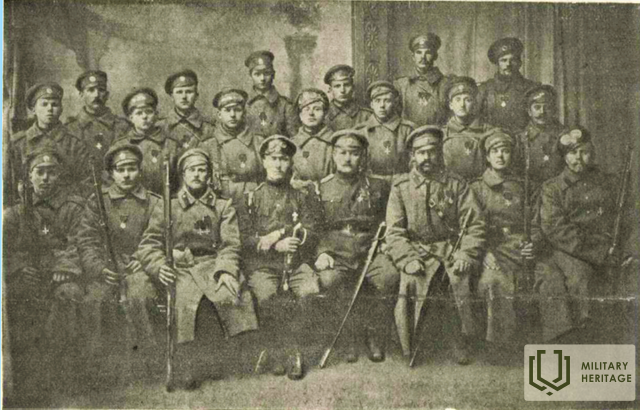
Pirmojo pasaulinio karo pradžioje Latvijos karininkai ne kartą kreipėsi į aukštesnio rango Rusijos karines institucijas su pasiūlymais Rusijos armijos sudėtyje sukurti Latvijos nacionalinius karinius darinius. Tačiau šios iniciatyvos buvo atmestos. 1914 m. pabaigoje Daugavgryvos tvirtovėje buvo suformuoti du Daugavgryvos tvirtovės gvardijos jungtinių darbo kuopų batalionai, kurie nuo 1915 m. kovo mėn. dalyvavo mūšiuose Lietuvoje, o vėliau Žiemgaloje ir Kurše. Sėkmingi Latvijos gvardijos veiksmai 1915 m. gegužės mėn. vykusiuose Jelgavos gynybos mūšiuose vėl iškėlė Latvijos nacionalinių darinių kūrimo klausimą. 1915 m. rudenį ir žiemą abu gvardijos batalionai buvo naudojami kaip personalas Latvijos šaulių daliniams formuoti.
Nacionalinės gvardijos formavimas Rusijos imperijoje Pirmojo pasaulinio karo metu buvo vykdomas pagal 1910 m. patvirtintus mobilizacijos reglamentus. Į Nacionalinę gvardiją buvo šaukiami 21–42 metų vyrai, atleisti iš tarnybos reguliariojoje armijoje. Nacionalinė gvardija pirmiausia buvo skirta užnugario tarnybai – karinių ir strateginių inžinerinių objektų apsaugai, tvirtovių ir miestų garnizono tarnybai, taip pat reguliariosios armijos dalinių papildymui. Nacionalinės gvardijos daliniai dažnai buvo naudojami karinių objektų statyboje. Dėl šios priežasties specialiųjų darbų kuopos netgi buvo formuojamos neaprūpinant jų ginklais.
Daugavgryvos tvirtovės poreikiams buvo paskirtos 13 Namų apsaugos darbo kuopų. 1914 m. rudenį Namų apsaugos kuopos daugiausia buvo naudojamos pozicijų aplink tvirtovę statybai. Nuo 1914 m. lapkričio pabaigos aštuonios Namų apsaugos ginkluotos kuopos, atleistos nuo statybos darbų, pradėjo intensyvius karinius mokymus, kad kompensuotų reguliariosios armijos dalinių trūkumą.
Pirmasis iš aštuonių Latvijos šaulių batalionų pradėtas formuoti 1915 m. rugpjūtį. Jam suteiktas Daugavgryvos pavadinimas. Tai nebuvo atsitiktinumas, nes Daugavgryvos tvirtovė tapo Latvijos dalinių namais. Iš tvirtovės garnizono darbinių kuopų, kuriose absoliuti dauguma buvo latviai, buvo suformuoti du nacionalinės gvardijos batalionai, kurie 1915 m. pavasarį dalyvavo mūšiuose su vokiečiais Kurše ir Šiaurės Lietuvoje. Tvirtovės vado adjutantas K. Baltiņš atliko pirmųjų šaulių batalionų vado pareigas ir dirbo Latvijos šaulių organizacijos komitete.
Pirmieji šaulių batalionai buvo suformuoti labai skubotai. Frontas buvo netoli Rygos, ir vokiečių puolimas galėjo prasidėti bet kurią akimirką. Trūko vietos šauliams dislokuoti, nebuvo aprangos ir įrangos. Šauliai taip pat vėlavo gauti ginklų. 1-asis Daugavgryvos latvių šaulių batalionas ginklus gavo praėjus mėnesiui po jo įkūrimo, bet uniformas ir pakinktus – dar vėliau. Taip pat trūko patyrusių instruktorių ir karininkų. Neturint ginklų ir pakankamo vadovaujančio personalo, mokymo procesas buvo sunkus. Tai kėlė nerimą tiek šauliams, tiek karininkams. Mokymą taip pat apsunkino dažnas šaulių savavališkas nebuvimas darbe.
Apskritai reikia pripažinti, kad Latvijos šaulių organizacijos komiteto darbas buvo pagirtinas. Per trumpą laiką, labai sunkiomis sąlygomis ir neturint ankstesnės patirties, buvo suformuoti keli kovai parengti batalionai. Tai buvo didelė sėkmė ir Latvijos visuomenės saviorganizacinių gebėjimų įrodymas.
1916 m. lapkritį visi Latvijos šaulių batalionai buvo pervadinti į pulkus.
Daugiau informacijos šaltinių
1. Šiliņš J. „Latvių šauliai“. Nacionalinė enciklopedija. https://enciklopedija.lv/skirklis/31625-latviešu-strēlnieki [žiūrėta 2021-10-29].
2. Dedumietis D. „Daugavgryvos tvirtovės nacionalinės gvardijos jungtinių darbo kuopų batalionai“. Nacionalinė enciklopedija. https://enciklopedija.lv/skirklis/58908-Daugavgrīvas-cietokšņa-zemessargu-apvienoto-darba-rotu-bataljoni [žiūrėta 2021-10-29].
3. Sielų pūga. Skaitmeninis muziejus. Prieinama: https://www.dveseluputenis.lv/lv/laika-skala/notikums/74/pirmo-latviesu-strelnieku-bataljona-formesana/ [žiūrėta: 2021-10-29].
Susijusi laiko juosta
Susijusios vietos
Daugavgryvos tvirtovė
Daugavgryvos tvirtovė (įėjimas iš Birzės gatvės) yra Daugavgryvos saloje, kur Bulupės upė įteka į Dauguvos upę. Tvirtovė buvo pastatyta XVII a., siekiant apsiginti nuo priešų, judančių Rygos kryptimi, kuri buvo svarbus administracinis, prekybos ir gamybos centras. Vėliau ji tapo pagrindiniu Latvijos armijos pakrantės gynybos įtvirtinimu su keliais atramos taškais. Ši gynybinė įtvirtinimų sistema yra vienas vertingiausių Latvijos karinio paveldo objektų. Ši tvirtovė yra Latvijos karinės istorijos liudininkė. Pavyzdžiui, Krymo karo metu (1853–1856 m.) čia buvo mokomos Latvijos ir Estijos patrankinių valčių įgulos. Pagrindinis šių dalinių tikslas buvo ginti vietos uostus ir pakrantę nuo britų karinio jūrų laivyno atakų. Pirmojo pasaulinio karo metu čia buvo suformuotos Daugavgryvos milicijos kuopos. Tai buvo pirmieji Latvijos koviniai daliniai, atsiradę dar anksčiau nei Latvijos šauliai. Šiandien galima pamatyti tvirtovės teritoriją. Netoliese yra Kometfortas ir Pajūrio gamtos parkas, o kitoje Dauguvos pusėje – Mangaļsalos įtvirtinimai.
Kalėdų mūšių muziejus
Muziejus, įsikūręs sodyboje „Mangaļi“ Jelgavos apylinkėse, Valgundės seniūnijoje, yra Latvijos karo muziejaus filialas. Jis atidarytas 2005 m. toje vietoje, kurioje per Pirmąjį pasaulinį karą vyko Kalėdų mūšiai. Šiose vietose iki šiol tebėra išlikę išskirtiniai Pirmojo pasaulinio karo įtvirtinimai. Kalėdų mūšių muziejaus ekspozicija yra įrengta autentiškoje vietoje po atviru dangumi. Čia galima pamatyti rekonstruotą įtvirtinimų sistemos fragmentą – lauko slėptuvę ir dalį pirmosios vokiečių gynybos linijos, vadinamos „vokiečių pyli mu“. Tai vienintelis tokio pobūdžio objektas Baltijos šalyse. Kalėdų mūšiai – vienas žinomiausių ir dramatiškiausių Pirmojo pasaulinio karo įvykių Latvijoje. Jie užima ypatingą vietą latvių karo ir kultūros istorijoje. Intensyvūs mūšiai truko šešias dienos ir pareikalavo daug aukų. Šie įvykiai dažniausiai siejami su latvių šaulių puolimu prieš Vokietijos kariuomenę, vykusiu ypač atšiauriomis ir nepalankiomis žiemos sąlygomis. Tai buvo pirmas kartas, kai didelio masto puolimas vyko be artilerijos palaikymo.
Šiuo metu muziejuje eksponuojami mūšių vietose rasti radiniai. Vidaus ekspozicija lankoma nustatytu laiku, o po atviru dangumi esančių įtvirtinimų ekspoziciją galima apžiūrėti kiekvieną dieną. Apylinkėse sudaryti turistiniai maršrutai ir įrengti pažintiniai takai.
Nordeķi – Kalnciemo kopagūbris
Maždaug 30 km ilgio kopų ketera, kurią gamtoje galima atsekti nuo Iļģuciemo (su nedideliais pertraukimais) iki Tyrelių, yra vienas įspūdingiausių Pajūrio žemumų reljefo formų, kuris retai suvokiamas kaip vientisas natūralus darinys. Kopa susidarė vieno iš paskutiniųjų Baltijos ledyninių ežerų pakrantėje, slūgstant Baltijos ledyninio ežero vandeniui. Kopų keterą sudaro dvi lygiagrečios 50–100 m pločio kopų juostos. Jos paprastai būna 6–10 m aukščio, tačiau aukščiausi jų taškai siekia 16–19 m virš jūros lygio. Kleistų, Imantos ir Beberbekių apylinkėse kopas dengiantys gražūs pušynai yra populiari pasivaikščiojimų, poilsio ir sporto, o žiemą – slidinėjimo vieta. Kopos dalis Lačupytė apylinkėse siejama su Bermontiadų įvykiais. Ant kopos Pārdaugavoje yra Lačupės arba Lacarų kapinės . Tarp Pinkių ir Babytės įkurtas Beberbekių gamtos parkas kopoms išsaugoti. Vakarinė Nordekių-Kalnciemo kopų keteros dalis, maždaug 10 km ilgio, vadinama Ilgąja kopa . Netoli Ilgosios kopos (į pietus nuo Trenčių) yra Antinių brolių kapinės , Latvijos šaulių ligoninės vaistų sandėlis ir atnaujinti Latvijos šaulių žeminės . Į pietus nuo Ilgosios kopos yra pelkėtų miškų ir pelkių masyvas, įskaitant Ravėjų ir Maztīrelį . Priešais Maztīrelį yra Ložmetējkalnas su apžvalgos bokštu ir poilsio vieta bei vadinamąja vokiečių pylimo atkarpa . Dar toliau į vakarus, netoli Ilgosios kopos, yra Latvijos šaulių brolių kapinės ir Pikių brolių kapinės. Su didesniais ar mažesniais pertraukimais, beveik per visą Nordekių-Kalnciemo kopų keterą matomi apkasai. Pietvakarinėje Ilgosios kopos dalyje – iš pietų prie jos besiribojančiuose pelkėtuose miškuose matomi Pirmojo pasaulinio karo bombų krateriai . Visu Ilgosios kopos ilgiu (į pietus nuo jos) driekiasi nedideli miško takeliai, tinkami pasivaikščiojimams ir ilgesniems žygiams – puiki proga apžiūrėti Pirmojo pasaulinio karo mūšių vietas.
Paminklas Jelgavos gynėjams
Paminklas Jelgavos gynėjams stovi Jelgavos apylinkėse, prie Svėtės mokyklos. Jis skirtas Daugavgryvos krašto apsaugos kariams, kurie 1915 m. balandžio pabaigoje sustabdė vokiečių kariuomenės veržimąsi į Jelgavą. 1915 m. gegužės pradžioje Jelgavoje buvo surengta iškilminga demonstracija, skirta šiam svarbiam įvykiui paminėti. Tai, kad latvių krašto apsaugos kariams pavyko sulaikyti vokiečių puolimą, tapo svarbiu argumentu – Janis Čakstė ir jo bendraminčiai tuo pasinaudojo siekdami įgyvendinti idėją kurti latvių šaulių dalinius Pirmojo pasaulinio karo metais.
Paminklas buvo atidengtas 1991 metais, o jo autorė – skulptorė Alvīne Veinbaha (1923–2011).
Susijusi istorija
Apie Daugavgryvos tvirtovę
Pasakotojas aprašo įvykį Daugavgryvos tvirtovėje Pirmojo pasaulinio karo metu, kai ją subombardavo vokiečių armijos dirižablis. Tvirtovė buvo vienas iš strateginių objektų, išlaikiusių savo svarbą iki Antrojo pasaulinio karo pabaigos.




